|
BumblebeeID
- find British species by colour pattern
The colour
pattern of this species is particularly variable. Black
hairs are fewest on individuals from northern Scotland,
and more abundant on those from southern Scotland, England
and Wales.
Distinguishing
similar species:
Unlike B. humilis
and B. muscorum,
B. pascuorum have (1) shaggy hair, (2) usually have at
least a few black hairs on the sides of abdominal segment 3 after
the waist (sometimes black hairs are completely absent), and (3)
in fresh specimens the hair on abdominal segment 1 is lighter
than the pale hair on segment 3; and males can be distinguished
by their
genitalia.
'Common
Carder-bee'
(Sladen,
1912; Step, 1932)
'Common
carder bee'
(Benton, 2000,
BBCT)
taxonomy
and nomenclature
|
A
very common medium-sized species, with a long tongue, emerging
in early spring, and nesting on the surface of the ground.
This species can be seen at flowers particularly late in the
year, often into November in southern Britain. In its nest
structure, Sladen (1912)
describes it as a 'pocket-making' 'carder bee'. Colonies are
small and relatively mild tempered when disturbed.
|
| Habitat |
Gardens,
farmland, woodland glades and edges, grassland, heathland,
uplands, less common on marshes and bogs.
|
|
British
distribution
|
Throughout
Britain, except on the Scilly Isles, Outer Scottish Isles,
and Shetland. Recently, it has become established on the Orkneys
(Plowright et al., 1997).
Data from Alford (1980)
are mapped on a 10 km grid (left) to show local patchiness
and on a 50 km grid (right) to show the regional pattern (dark
blue - all post 1960):
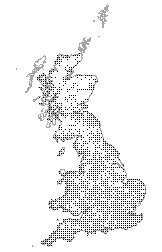
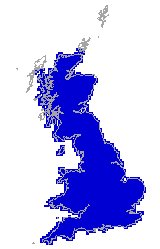
|
Worldwide
distribution
|
Europe
and northern Asia to the Pacific. World distribution mapped
on an equal-area grid (dark
blue spots for specimens identified by PHW, light blue spots
for literature records, white spots for expected distribution):
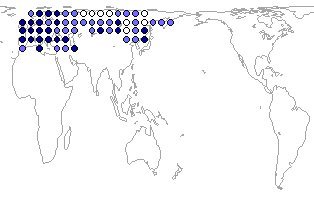
|
Queens and
workers with a pale band at the front of the thorax
are rare and may occur particularly after inclement
weather (Sladen, 1912).
Distinguishing
similar species:
Unlike B. ruderarius,
B. lapidarius queens and workers (1) have the long hairs
of the pollen baskets (corbiculae) on the hind legs entirely black,
and (2) have the mid basitarsi with the posterior angle rounded
without a spine; and males (1) have the face bright yellow and
(2) the antennae are short (see Prys-Jones & Corbet, 1987,
1991).
Unlike B. cullumanus,
B. lapidarius queens and workers have the hind basitarsi
with many orange short feathered hairs on their outer surface
(see Prys-Jones & Corbet, 1987,
1991); and males (1) usually have a bright lemon-yellow face
and bands, and (2) can be distinguished by their genitalia.
Unlike B. pomorum and
the dark form of B. sylvarum,
B. lapidarius queens and workers have the mid basitarsi
with the posterior angle rounded without a spine (see Prys-Jones
& Corbet, 1987, 1991);
and males (1) have short antennae, and (2) can be distinguished
by their
genitalia.
|
'Stone
Humble-bee'
(Sladen,
1912)
'Large Red-tailed Humble-bee'
(Step, 1932)
'Red-tailed
bumblebee'
(Benton, 2000,
BBCT)
taxonomy
and nomenclature
|
A very
common species in the south, with large queens, a short
tongue, emerging in early spring, and usually nesting below
the surface of the ground (though sometimes on the surface
under objects, or above the surface in cavities). This species
has a relatively short period of male activity when males
may be very abundant. In its nest structure, Sladen (1912)
describes it as a 'pollen-storer' species. Colonies are
often large.
|
| Habitat |
Gardens,
farmland, woodland glades and edges, grassland, heathland,
less common in uplands, on marshes and bogs.
|
|
British
distribution
|
Throughout
Britain, except in parts of northern Scotland, on the Outer
Scottish Isles, Orkneys, and Shetland. Recently it has been
spreading in northern Scotland (Macdonald, 2001).
Data from Alford (1980)
are mapped on a 10 km grid (left) to show local patchiness
and on a 50 km grid (right) to show changes in the regional
pattern (dark blue - post 1960; light blue - pre 1960 only):
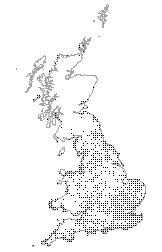 
|
| Worldwide
distribution |
Europe
and north Africa, east to the Urals and possibly the Ob. World
distribution mapped on an equal-area
grid (dark
blue - specimens identified by PHW; light blue - literature
records; white - expected distribution):
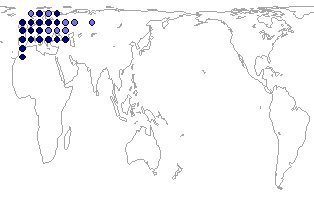
|
Distinguishing
similar species:
Unlike orange-tailed B.
jonellus, B. pratorum queens and workers lack a
pale band at the rear of the thorax; and the males can be distinguished
by their genitalia.
|
'Early-nesting
Humble-bee'
(Sladen,
1912)
'Early Humble-bee'
(Step, 1932)
'Early-nesting
bumblebee'
(Benton, 2000)
'Early
bumblebee'
(BBCT)
taxonomy
and nomenclature
|
A common
small species, with a short tongue, emerging in early spring,
and nesting below the surface of the ground, though sometimes
on the surface under objects, or above the surface in cavities.
This species nests particularly early in the year. It is
less often seen in late summer and these records may often
be for bees reared in secondary nests by queens produced
earlier in the same year. In its nest structure, Sladen
(1912) describes it as
a 'pollen-storer' species. Colonies are small and relatively
mild tempered when disturbed.
|
| Habitat |
Gardens,
farmland, woodland glades and edges, less common in grassland,
heathland, uplands, on marshes and bogs.
|
|
British
distribution
|
Throughout
Britain, except on the Scilly Isles, Outer Scottish Isles,
Orkneys, and Shetland. Benton (2000)
suggests that this species is becoming increasingly urban
because it is intolerant of agricultural intensification.
In Kent it remains widespread in farmland. Data from Alford
(1980) are mapped on a
10 km grid (left) to show local patchiness and on a 50 km
grid (right) to show the regional pattern (dark blue - all
post 1960):
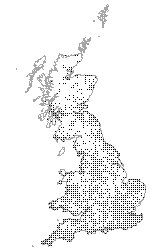 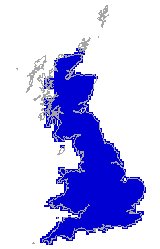
|
| Worldwide
distribution |
Europe
east to Yakutsk. World distribution mapped on an equal-area
grid (dark
blue - specimens identified by PHW; light blue - literature
records; white - expected distribution):
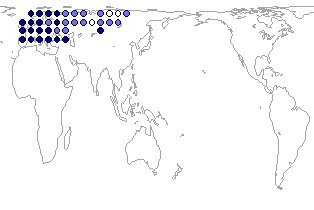
|
The
paler form from eastern continental Europe is being
imported for the pollination of glasshouse crops. It
may occasionally be found outside of glasshouses.
Distinguishing
similar species:
Unlike B. lucorum, B. terrestris
have (1) at least some brownish hairs at the front of the white
tail, (2) usually have more golden bands, and (3) differ in the
patterns of small punctures on the top of the head (see Løken,
1973).
Unlike
B. soroeensis,
B. terrestris queens and workers have (1) the first segment
of the abdomen after the waist black, (2) the second segment is
yellow in the middle, (3) the hind basitarsus has a strongly arched
hind margin; and for males (1) the antennae are short, (2) the
base of the hind basitarsus broadens with a distinct shoulder
(see Prys-Jones & Corbet, 1987,
1991), and (3) can be distinguished by their genitalia.
|
'Large
Earth Humble-bee'
(Sladen,
1912)
'Buff-tailed Humble-bee'
(Step, 1932)
'Buff-tailed
bumblebee'
(Benton, 2000,
BBCT)
taxonomy
and nomenclature
|
A very
common species in the south, with particularly large queens,
a short tongue, emerging in early spring, and usually nesting
below the surface of the ground (though sometimes on the
surface under objects, or above the surface in cavities).
In southern Britain this species has been found flying in
every month of some recent years, with queens, workers and
even males seen in January and February. In its nest structure,
Sladen (1912) describes
it as a 'pollen-storer' species. Colonies are often large
and can be aggressive when disturbed.
|
| Habitat |
Gardens,
farmland, woodland glades and edges, grassland, heathland,
less common on uplands, marshes and bogs.
|
|
British
distribution
|
Throughout
Britain, except in northern Scotland, on the Outer Scottish
Isles, Orkneys, and Shetland, although it has been spreading
in northern Scotland (Macdonald, 2001).
Data from Alford (1980)
are mapped on a 10 km grid (left) to show local patchiness
and on a 50 km grid (right) to show changes in the regional
pattern (dark blue - post 1960; light blue - pre 1960 only):
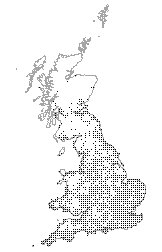 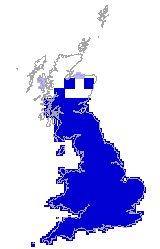
|
| Worldwide
distribution |
Indigenous
distribution in central and southern Europe, north
Africa, Madeira and the Canary Isles, east to Mongolia
(this species has been introduced
to particularly many additional areas). World distribution
mapped on an equal-area
grid (dark
blue - specimens identified by PHW; light blue -
literature records; white - expected distribution):
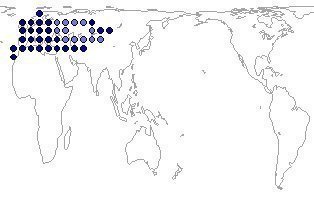
|
Populations
from the uplands of the north and west of Britain have
long been known to have some larger females, with broader
paler bands. These bees, known as B.
magnus, are often difficult to separate consistently.
Another form, often with a narrow black S-shaped cross
band at the side of the yellow thoracic collar of the
females (just anterior to the wing bases), has been
described under the name B.
cryptarum. Until recently, this was not known
to occur in Britain, although there are now records
from Scotland (Bertsch et al., 2004,
2005) and Ireland. Workers, males, and even queens
of these bees can at present be distinguished reliably
only from their DNA sequences.
Distinguishing
similar species:
Unlike B. terrestris, B.
lucorum have (1) no brownish hairs at the front of the white
tail, (2) usually have more lemon-yellow bands, and (3) differ
in the patterns of small punctures on the top of the head (see
Løken, 1973).
Unlike
B. soroeensis,
B. lucorum queens and workers have (1) the first segment
of the abdomen black, (2) the second segment is yellow in the
middle, (3) the hind basitarsus has a strongly arched hind margin;
and for males (1) the antennae are short, (2) the base of the
hind basitarsus broadens with a distinct shoulder (see Prys-Jones
& Corbet, 1987, 1991),
and (3) can be distinguished by their
genitalia.
|
'Small
Earth Humble-bee'
(Sladen,
1912; Step, 1932)
'White-tailed
bumblebee'
(Benton, 2000,
BBCT)
taxonomy
and nomenclature
|
A common
species especially in the north, with medium body size (larger
in the northwestern pale form), a short tongue, emerging
in early spring, and usually nesting below the surface of
the ground (though sometimes on the surface under objects,
or above the surface in cavities). This species has recently
been reported as flying in February in the south (Benton,
2000). In its nest structure,
Sladen (1912) describes
it as a 'pollen-storer' species. Colonies of this species
in the south are usually smaller than those of B. terrestris.
|
| Habitat |
Gardens,
farmland, woodland glades and edges, grassland, heathland,
uplands, marshes, bogs.
|
|
British
distribution
|
Throughout
Britain. Data from Alford (1980)
are mapped on a 10 km grid (left) to show local patchiness
and on a 50 km grid (right) to show the regional pattern (dark
blue - all post 1960):
 
|
| Worldwide
distribution |
Indigenous
distribution in Europe, Asia including the Himalaya,
Alaska, and Canada east almost to Hudson Bay. World
distribution mapped on an equal-area
grid (dark
blue - specimens identified by PHW; light blue -
literature records; white - expected distribution):
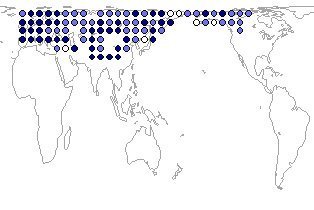
|
The
yellow bands are often narrowed (especially at the rear
of the thorax), but entirely black individuals are rare.
Despite some recent claims, B. hortorum has long
been and still is regarded as a species separate from
B. ruderatus
by specialists in bumblebee taxonomy (references in
Williams & Hernandez, 2000
[pdf]).
Distinguishing
similar species:
Unlike B.
ruderatus, B. hortorum (1) have the anterior
edge of the white hairs of the tail forming a straight
line across the abdomen, not extending further forwards
at the sides of the abdomen than in the middle, (2)
always have at least some yellow hairs at the front
centre of abdominal segment 2, and (3) usually have
the pale band at the rear of the thorax much narrower
in the middle than the yellow collar at the front of
the thorax (Williams & Hernandez, 2000
[pdf]).
Unlike B. jonellus,
B. hortorum (1) have the head much longer than
broad, (2) queens and workers have a spine on the mid
basitarsus (see Prys-Jones & Corbet, 1987,
1991), and (3) males can be distinguished by their
genitalia.
|
'Small
Garden Humble-bee'
(Sladen,
1912; Step, 1932)
'Garden
bumblebee'
(Benton, 2000,
BBCT)
taxonomy
and nomenclature
|
A common
medium-sized species, with a long tongue, emerging in late
spring, and nesting below the surface of the ground, though
sometimes on the surface under objects, above the surface
in cavities, or on the surface.
It is less often seen in late summer and these records may
sometimes be for bees reared in secondary nests by queens
produced earlier in the same year. In its nest structure,
Sladen (1912) describes
it as a 'pocket-making' 'pollen-primer' species. Colonies
of this species are small.
|
Habitat
|
Gardens,
farmland, woodland glades and edges, grassland, heathland,
less common in uplands, on marshes and bogs. This is one of
the more common species within woodlands in midsummer.
|
|
British
distribution
|
Throughout
Britain. Data from Alford (1980)
are mapped on a 10 km grid (left) to show local patchiness
and on a 50 km grid (right) to show the regional pattern (dark
blue - all post 1960):
 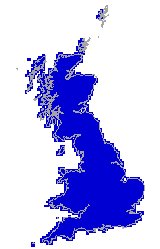
|
| Worldwide
distribution |
Indigenous
distribution in Europe and northern Asia to the
Pacific. World distribution mapped on an equal-area
grid (dark
blue - specimens identified by PHW; light blue -
literature records; white - expected distribution):
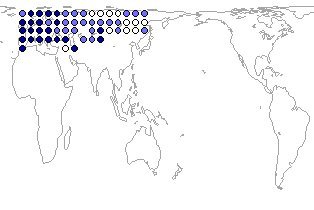
|
alphabetic
British list | distribution
of British species | colour
patterns | colour
diagrams
 top of page
top of page
|